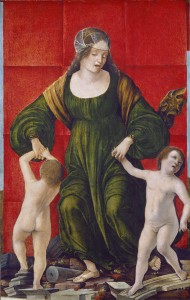![Sperandio<br /><i>Ercole d’Este (1431–1505), Duke of Ferrara, and Eleanora of Aragon (1450–1493), His Wife (1473)</i> [obverse], c. 1473<br />Lead alloy, diameter 11.29 cm (4 7/16 in.)<br />National Gallery of Art, Washington, DC, Samuel H. Kress Collection<br />Image courtesy of the Board of Trustees, National Gallery of Art](http://italianrenaissanceresources.com/wp-content/uploads/2013/03/RP_124-300x295.jpg)
Sperandio
Ercole d’Este (1431–1505), Duke of Ferrara, and Eleanora of Aragon (1450–1493), His Wife (1473) [obverse], c. 1473
Lead alloy, diameter 11.29 cm (4 7/16 in.)
National Gallery of Art, Washington, DC, Samuel H. Kress Collection
Image courtesy of the Board of Trustees, National Gallery of Art

Ercole de’ Roberti
The Wife of Hasdrubal and Her Children, c. 1490/93
Tempera on panel, 47.3 x 30.6 cm (18 5/8 x 12 1/16 in.)
National Gallery of Art, Washington, DC, Ailsa Mellon Bruce Fund
Image courtesy of the Board of Trustees, National Gallery of Art
This painting speaks to the theme of virtuous women. It is one of three surviving panels by Ercole de’ Roberti that depict sacrifices made for family and state by strong, duty-minded women. Hasdrubal’s wife (her name is never given) was praised by Roman historian Appian for honor surpassing that of her husband. When his army was defeated, he was willing to endure capture and humiliation while his wife chose death over dishonor, flinging her children and herself into the flames of a burning temple. The artist downplayed the grisly aspects of the narrative in favor of a more decorative work. It is typical of paintings made in a courtly milieu, with brilliant color and attention to fine details. The children are nude, presented like putti and intertwined in an almost balletic dance with their mother. At their feet, bits of architectural ruins and small laps of flame only hint at their fate. The figures stand out dramatically against a crisply folded red curtain, the complementary green of the mother’s dress enhancing the linear elegance of her pose against it.
Ercole de’ Roberti, a native of Ferrara, joined the Ferrarese court in 1486 and remained until his death ten years later. Although the duke worked closely with him to design decorations at Belriguardo and other large projects, much of what the artist produced was ephemera such as pennants or pageant pavilions. He decorated wedding chests for Eleanora’s daughters Isabella and Beatrice, and he designed the triumphal chariot for Isabella’s wedding.